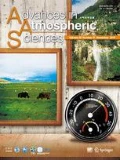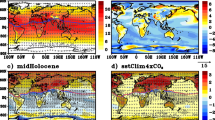Abstract
Using data from 17 coupled models and nine sets of corresponding Atmospheric Model Intercomparison Project (AMIP) results, we investigated annual and seasonal variation biases in the upper 50 m of the south-central equatorial Pacific, with a focus on the double-ITCZ bias, and examined the causes for the amplitude biases by using heat budget analysis. The results showed that, in the research region, most of the models simulate SSTs that are higher than or similar to observed. The simulated seasonal phase is close to that observed, but the amplitudes of more than half of the model results are larger than or equal to observations. Heat budget analysis demonstrated that strong shortwave radiation in individual atmospheric models is the main factor that leads to high SST values and that weak southward cold advection is an important mechanism for maintaining a high SST. For seasonal circulation, large surface shortwave radiation amplitudes cause large SST amplitudes.
Similar content being viewed by others
References
Adler, R. F., and Coauthors, 2003: The version-2 global precipitation climatology project (GPCP) monthly precipitation analysis (1979-present). J. Hydrometeor., 4, 1147–1167.
Bellucci, A., S. Gualdi, and A. Navarra, 2010: The double-ITCZ syndrome in coupled general circulation models: The role of large-scale vertical circulation regimes. J. Climate, 23, 1127–1145.
Carton, J. A., and B. S. Giese, 2008: A reanalysis of ocean climate using Simple Ocean Data Assimilation (SODA). Mon. Wea. Rev., 136, 2999–3017.
Collins, W. D., and Coauthors, 2006: The Community Climate System Model Version 3 (CCSM3). J. Climate, 19, 2122–2143.
Delworth, T. L. and Coauthors, 2006: GFDL’s CM2 global coupled climate models-Part 1: Formulation and simulation characteristics. J. Climate, 19(5), 643–674.
de Szoeke, S. P., and S. P. Xie, 2008: The tropical eastern Pacific seasonal cycle: Assessment of errors and mechanisms in IPCC AR4 coupled ocean-atmosphere general circulation models. J. Climate, 21, 2573–2590.
Gent, P. R., and Coauthors, 2011: The community climate system model version 4. J. Climate, 24, 4973–4991.
Gordon, C., C. Cooper, C.A. Senior, H. T. Banks, J. M. Gregory, T. C. Johns, J. F. B. Mitchell, and R. A. Wood, 2000: The simulation of SST, sea ice extents and ocean heat transports in a version of the Hadley Centre coupled model without flux adjustments. Climate Dyn., 16, 147–168.
Gordon, H. B., and Coauthors, 2002: The CSIRO Mk3 Climate System Model. CSIRO Atmospheric Research technical paper, No. 60, 130 pp.
Grist, J. P., and S. A. Josey, 2003: Inverse analysis adjustment of the SOC air-sea flux climatology using ocean heat transport constraints. J. Climate, 16, 3274–3295.
Gualdi, S., E. Scoccimarro, and A. Navarra, 2008: Changes in tropical cyclone activity due to global warming: Results from a high-resolution coupled general circulation model. J. Climate, 21, 5204–5228.
Gulev, S., T. Jung, and E. Ruprecht, 2007: Estimation of the impact of sampling errors in the VOS observations on air-sea fluxes. Part I. Uncertainties in climate means. J. Climate, 20, 279–301.
Hasumi H., and S. Emori, 2004: K-1 coupled model (MIROC) description, K-1 technical report 1, Center for Climate System Research, University of Tokyo, 34pp. [Available online at http://www.ccsr.u-tokyo.ac.jp/kyosei/hasumi/MIROC/techrepo.pdf
Johns, T. C., and Coauthors, 2006, The new Hadley Centre climate model HadGEM1: Evaluation of coupled simulations. J. Climate, 19, 1327–1353.
Jungclaus, J.H., and Coauthors, 2006: Ocean circulation and tropical variability in the AOGCM ECHAM5/MPI-OM. J. Climate, 19, 3952–3972.
Kent, E. C., and D. I. Berry, 2005: Quantifying random measurement errors in voluntary observing ships’ meteorological observations. Int. J. Climatol., 25, 843–856, doi: 10.1002/joc.1167.
Large, W. G., and S. G. Yeager, 2008: The global climatology of an interannually varying air-sea flux data set. Climate Dyn., 24, 341–364, doi: 10.1007/s00382-008-0441-3.
Lee, T., I. Fukumori, and B. Y. Tang, 2004: Temperature advection: Internal versus external processes. J. Phys. Oceanogr., 34, 1936–1944.
Li, J. L., X. H. Zhang, Y. Q. Yu, and F. S. Dai, 2003: Double ITCZ phenomenon and analysis of its heat budget in a coupled ocean-atmosphere general circulation model. Acta Meteorologica Sinica, 61, 39–51. (in Chinese)
Lin, J. L., 2007: The double-ITCZ problem in IPCC AR4 coupled GCMS: ocean-atmosphere feedback analysis. J. Climate, 20(18), 4497–4525.
Liu, H. L., W. Y. Lin, and M. H. Zhang, 2010: Heat budget of the upper ocean in the south-central equatorial Pacific. J. Climate, 23(7), 1779–1792.
Liu, H. L., M. H. Zhang, and W. Y. Lin, 2012: An Investigation of the Initial Development of the Double-ITCZ Warm SST Biases in the CCSM. J. Climate, 25(1), 140–155.
Ma, C. C., C. R. Mechoso, A. W. Robertson, and A. Arakawa, 1996: Peruvian stratus clouds and the tropical Pacific circulation: A coupled ocean-atmosphere GCM study. J. Climate, 9, 1635–1645.
Marti, O., and Coauthors, 2005: The new IPSL climate system model: IPSL-CM4, Note du Pôle de Modêlisation, IPSL, 26, 1–86.
Mechoso, C. R., and Coauthors, 1995: The seasonal cycle over the tropical Pacific in coupled ocean-atmosphere general circulation models. Mon. Wea. Rev., 123, 3825–3838.
Meehl, G. A., W. M. Washington, C. Ammann, J. M. Arblaster, T. M. L. Wigley, and C. Tebaldi, 2004: Combinations of natural and anthropogenic forcings and 20th century climate. J. Climate, 17, 3721–3727.
Rosati, A., and K. Miyakoda, 1988: A general circulation model for upper ocean simulation. J. Phys. Oceanogr., 18, 1601–1626.
Russell, G. L., J. R. Miller, and D. Rind, 1995: A coupled atmosphere-ocean model for transient climate change studies. Atmos.-Ocean, 33(4), 683–730.
Salas-Mélia D., and Coauthors, 2005: Description and validation of the CNRM-CM3 global coupled model. CNRM working note 103, 36 pp.
Song, X. Z., and L. S. Yu, 2012: High-latitude contribution to global variability of air-sea sensible heat flux. J. Climate, 25(10), 3515–3531. doi: 10.1175/JCLI-D-11-00028.1.
Schmidt, G. A., and Coauthors, 2006: Present day atmospheric simulations using GISS ModelE: Comparison to in-situ, satellite and reanalysis data. J. Climate, 19, 153–192.
Xu, Y., Z. C. Zhao, Y. Luo, and X. J. Gao 2005: Climate change projections for the 21st century by the NCC/IAP T63 model with SRES scenarios. Acta Meteorologica Sinica, 19, 407–417.
Yu, L. S., 2007: Global variations in oceanic evaporation (1958-2005): The role of the changing wind speed. J. Climate, 20, 5376–5390, doi: 10.1175/2007JCLI1714.1.
Yu, L. S., and R. A. Weller, 2007: Objectively analyzed air-sea heat fluxes for the global ice-free oceans (1981–2005). Bull. Amer. Meteor. Soc., 88(4), 527–539, doi: 10.1175/BAMS-88-4-527.
Yu, Y. Q., X. H. Zhang, and Y. F. Guo, 2004: Global coupled ocean-atmosphere general circulation models in LASG/IAP. Adv. Atmos. Sci., 21, 444–455.
Zhang, G. J., and X. L. Song, 2010: Convection parameterization, tropical Pacific double ITCZ, and upper-ocean biases in the NCAR CCSM3. Part II: Coupled feedback and the role of ocean heat transport. J. Climate, 23, 800–812.
Zhang, X. H., W. Y. Lin, and M. H. Zhang, 2007: Toward understanding the double Intertropical Convergence Zone pathology in coupled ocean-atmosphere general circulation models. J. Geophys. Res., 112(D12), doi: 10.1029/2006JD007878.
Zhang, Y. C., W. B. Rossow, A. A. Lacis, V. Oinas, and M. I. Mishchenko, 2004: Calculation of radiative fluxes from the surface to top of atmosphere based on ISCCP and other global data sets: Refinements of the radiative transfer model and the input data. J. Geophys. Res., 109, D19105, doi: 10.1029/2003JD004457.
Zheng, Y. X., T. Shinoda, J. L. Lin, and G. N. Kiladis, 2011: Sea surface temperature biases under the stratus cloud deck in the southeast Pacific Ocean in 19 IPCC AR4 coupled general circulation models. J. Climate, 24(15), 4139–4164.
Author information
Authors and Affiliations
Corresponding author
Rights and permissions
About this article
Cite this article
Liu, X., Liu, H. Heat budget of the south-central equatorial Pacific in CMIP3 models. Adv. Atmos. Sci. 31, 669–680 (2014). https://doi.org/10.1007/s00376-013-2299-5
Received:
Revised:
Accepted:
Published:
Issue Date:
DOI: https://doi.org/10.1007/s00376-013-2299-5




